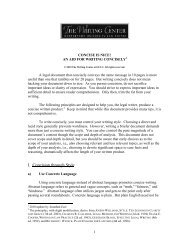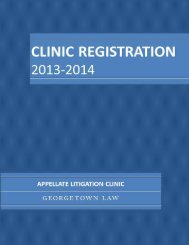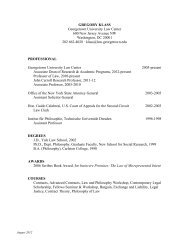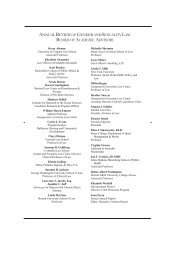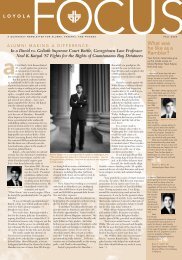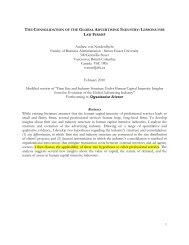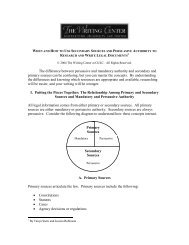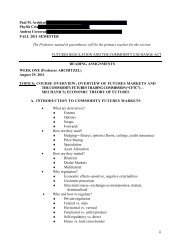Date: April 12, 2013 Topic: The Shrinking ... - Georgetown Law
Date: April 12, 2013 Topic: The Shrinking ... - Georgetown Law
Date: April 12, 2013 Topic: The Shrinking ... - Georgetown Law
Create successful ePaper yourself
Turn your PDF publications into a flip-book with our unique Google optimized e-Paper software.
General Counsel with Power? 2011 <br />
750 to 650 in the past two years, as part of a corporate-‐wide drive to reduce all costs. Another energy <br />
company implemented its policy to create a lean legal function, reducing in-‐house lawyers from 30 to <strong>12</strong>. <br />
Similarly, at a construction company, the total legal department headcount went down from 25 to 7 in <br />
five years with the creation of a global headquarter legal function. <br />
Shape of Legal Departments <br />
<strong>The</strong> internal legal department mirrors the corporate structure in some form. At its simplest, a single <br />
product firm operating in one country has a functional structure. <strong>The</strong> structure inevitably becomes <br />
more complex with multiple business lines and/or cross-‐national geographic coverage. With complexity <br />
comes a certain degree of freedom in choosing among alternative structures for the in-‐house legal <br />
function. <br />
<strong>The</strong>re is clearly a trade-‐off in this choice. <strong>The</strong> advantage of a centralized legal function is that the <br />
general counsel is in full control of overseeing all in-‐house lawyers. However, in-‐house lawyers may not <br />
give the best advice if they are remote from the business context. By contrast, by embedding <br />
themselves in business units or country operations, in-‐house lawyers acquire an intimate knowledge of <br />
the corporation for which they work. However, this devolved reporting structure hinders the sharing of <br />
best practice and the optimal allocation of legal resources across business units. Some general counsel <br />
have devised structural and process mechanisms that minimize this trade-‐off. <br />
At one end of the spectrum, companies with a focused product or service have a centralized legal <br />
department structure, with all in-‐house lawyers reporting to the general counsel. If a corporation is <br />
focused in its product/service line but has an international presence, then it may have a legal <br />
department in each country-‐based or regional operation. In such a structure, only the headquarter-based<br />
lawyers have a solid reporting line to the group general counsel, whilst country-‐based lawyers <br />
have a solid reporting line to the country general manager and only a dotted line to the group general <br />
counsel. At the other end of the spectrum, large energy companies and financial institutions are <br />
typically both global and diversified in product/service lines. <strong>The</strong>n, the legal department structure tends <br />
to mirror the three-‐dimensional matrix applied to the firm, with geography, product, and function as <br />
dimensions. <br />
<strong>The</strong> matrix is a complex structure that rarely works well with a sole reliance on formal reporting lines. It <br />
is therefore not just a matter of whether in-‐house lawyers have solid or dotted line reporting to the <br />
general counsel or business unit head. Typically, the matrix also requires much informal coordination <br />
and communication. With such processes in place, a global headquarter legal function can be a ‘centre <br />
of excellence’ providing specialist support (e.g. in litigation, corporate transactions, etc.) to legal <br />
departments in diversified business units. However, when a headquarter practice group (e.g. in <br />
litigation) lacks connectivity with business unit lawyers, this may lead to uncoordinated actions, or a <br />
situation of ‘too many hammers in the same machinery’, as one general counsel put it. <br />
5 <br />
Said Business School | University of Oxford



